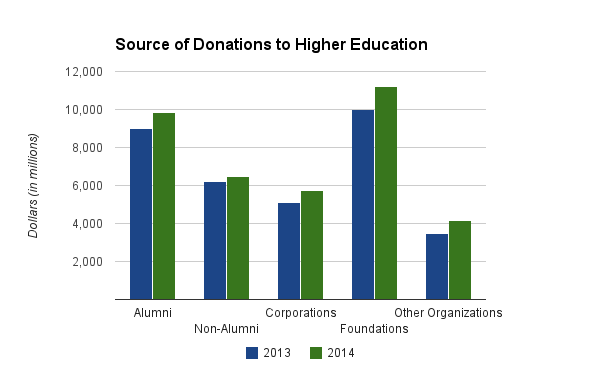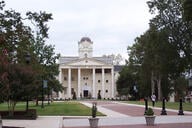You have /5 articles left.
Sign up for a free account or log in.
Charitable donations to colleges reached an all-time high of nearly $38 billion last year, according to an annual survey released today by the Council for Aid to Education.
Donors increased the amount they gave colleges in 2014 by 10.8 percent, up from $33.8 billion in 2013, which was the previous historic high. Without adjusting for inflation, the growth between 2013 and 2014 was the largest since 2000.
Gifts from all sources, including alumni, corporations and foundations, were up in 2014, although each source’s proportion of the total was roughly the same as it was in 2013.
While donations were up at most categories of institutions, a huge chunk of the total was brought in by a small group of elite American institutions. The top 20 colleges in fund-raising brought in more than $10 billion. That means that 28.6 percent of the total was given to fewer than 2 percent of the roughly 1,000 institutions that participated in the Council’s Voluntary Support of Education survey.
Harvard University tops the list (see below) with its $1.16 billion haul, and it became the second university to pass the $1 billion threshold after Stanford did in 2012. Of the top 20 universities, 5 are in California, including 3 within the University of California System.
Some of the other universities on the top of the list were boosted by large-scale, one-time gifts. The University of Texas at Austin, for example, placed seventh thanks to a nearly $217 million art gift that accounted for more than 40 percent of the university’s total. Likewise, Northwestern University is a newcomer on the list after more than doubling its intake with $616 million last year as part of a multiyear capital campaign.
University fund-raising efforts were lifted by a strong stock period that saw the four major stock indexes increase by double-digit percentage rates. Stock values affect individual wealth and especially gifts for capital purposes, which are often made as securities, according to the council. That boon also affected endowment levels, which have investment returns that are influenced by the markets. At the 959 institutions that gave data about their endowments, the total value of endowments increased by 15 percentIs this an average?.

The amount donated by alumni increased 9.4 percent in 2014, even as the alumni participation rate dropped slightly. The rate has been dropping steadily for at least 20 years, as it's grown easier to track down alumni, although many fund-raisers worry about the drop and say other factors also may be at play. Survey director Ann Kaplan said that that some colleges that report high alumni donor rates have poor records of alumni contact, which produces misleading information about the true alumni support.
The participation rate in 2014 was 8.3 percent, compared to 8.7 percent in 2013. At private liberal arts colleges, which as a group always have higher alumni giving rates, about 20 percent of alumni donate. Overall, the number of alumni donors increased 1.2 percent, and the average size of the gift, which is calculated as the mean, went up by about a quarter.
With ongoing concerns about student debt loads, Kaplan recently looked at past survey data to see if there was any sizable increase in gifts tied to scholarships. She didn’t find anything significant, but donations earmarked for student financial aid consistently make up the largest category of money earned through endowment gifts. In 2014, student aid represented 43.6 percent of all endowed gifts, up from 38.5 percent in 2013. That part of the survey is optional, meaning the number of responding institutions fluctuates year to year.
Kaplan has noticed what appears to be a recent spike in mega-gifts in the form of personal art collections donated to university museums. She’s not an expert on the art market, she said. But she points out in this year’s report that, in addition to the large gift at Texas, Colby College reported an art donation that was valued at $102.6 million. And in September, Stanford University opened a new museum anchored by a 121-piece collection of American art, although a value hasn’t been announced for the collection.
Kaplan predicts that giving to higher education will increase again during the current fiscal year, although it’s hard to say by what degree. Large individual gifts can swing the momentum. On average, 12 large gifts represented a third of the total at typical participating institutions.
Top Fund-Raisers in 2014
| Institution | Raised in 2014 |
| 1. Harvard U. | $1.16 billion |
| 2. Stanford U. | $929 million |
| 3. U. of Southern California | $732 million |
| 4. Northwestern U. | $616 million |
| 5. Johns Hopkins U. | $615 million |
| 6. Cornell U. | $546 million |
| 7. U. of Texas at Austin | $529 million |
| 8. U. of Pennsylvania | $484 million |
| 9. U. of Washington | $478 million |
| 10. Columbia U. | $470 million |
| 11. New York U. | $456 million |
| 12. U. of California at San Francisco | $445 million |
| 13. Duke U. | $437 million |
| 14. U. of Michigan | $433 million |
| 15. Yale U. | $430.31 million |
| 16. U. of California at Los Angeles | $430.28 million |
| 17. U. of Chicago | $405 million |
| 18. U of California at Berkeley | $390 million |
| 19. Massachusetts Institute of Technology | $375 million |
| 20. Indiana U. | $341 million |




